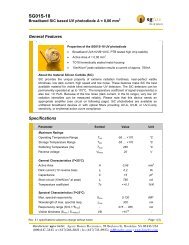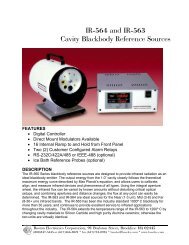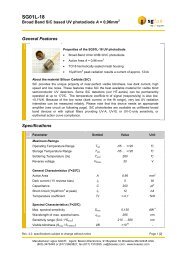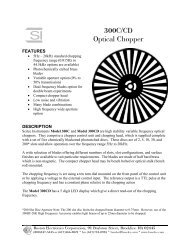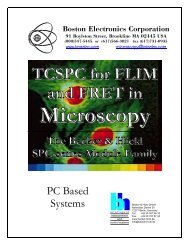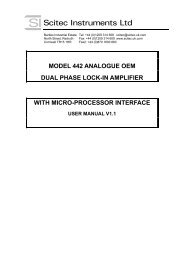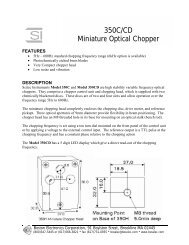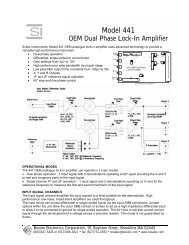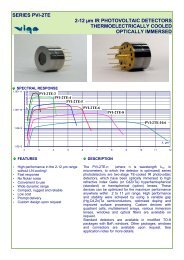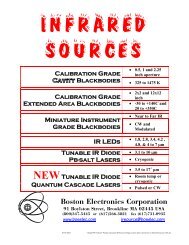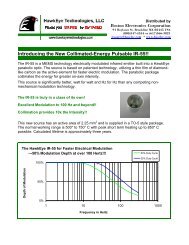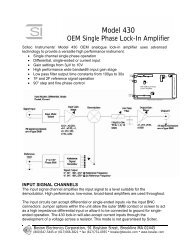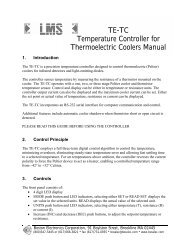IR Detectors from Vigo System - Boston Electronics Corporation
IR Detectors from Vigo System - Boston Electronics Corporation
IR Detectors from Vigo System - Boston Electronics Corporation
You also want an ePaper? Increase the reach of your titles
YUMPU automatically turns print PDFs into web optimized ePapers that Google loves.
About VIGO <strong>System</strong> S.A.VIGO <strong>System</strong> S.A. is a leading innovator and manufacturer ofuncooled infraredphotodetectors. The companyhas been established tocontinue development andcommercialization of uncooledmiddle and long wavelength <strong>IR</strong>detectors initiated by itsfounders in late 60's at MilitaryUniversity of Technology(Warsaw).Our mission is sensitive, fastconvenient and affordabledetection of <strong>IR</strong> radiation.The devices we develop arebased on unique concept of <strong>IR</strong>detector as device thatintegrates optical, detection andelectronic functions in one monolithic chip device, made ofband-gap engineered structures.At present we manufacture photodetectors optimized for anywavelength within the 2-16 um spectral range. The devices arecharacterized by performance close to the fundamental limitsand sub nanosecond time constants.VIGO <strong>System</strong> S.A. offers products ranging <strong>from</strong> a singleelement photodetectors to integrated detection modulescontaining optics, <strong>IR</strong> detector, coolers, preamplifiers, A/Dconverters and other electronics. We provide also advancedcustom engineering services.The devices have found numerous industrial, scientific,medical, military and other applications.VIGO <strong>System</strong> is located in the high-tech industrial park atOżarów Mazowiecki, western outskirt of Warsaw, Poland. Thecompany owns two buildings with combined 1400 sq. metersof production and office space.VIGO <strong>System</strong> S.A. is ISO 9001 certified.A.P. 25.09.2010Glossary of TermsInfrared <strong>Detectors</strong> <strong>from</strong> VIGO <strong>System</strong> S.A.Hg 1-xCd xTeKnown also as Mercury Cadmium Telluride (MCT), CdHgTe,(Cd,Hg)Te or Mercadtel. Alloy of CdTe and HgTe. Change ofthe CdTe to HgTe ratio (composition or x-value) can be usedto tune optical absorption cut-off wavelength in the wide range<strong>from</strong> UV to deep <strong>IR</strong>. Cooling shifts the cut-off wavelengthtowards long wavelengths. <strong>Detectors</strong> <strong>from</strong> <strong>Vigo</strong> are based oncomplex graded gap MCT structures optimized for MW<strong>IR</strong>(3-5 µm) and LW<strong>IR</strong> (8-14 µm) ranges.Current and Voltage Responsivity: R i, R vcurrent signal d R i=incident power d (in A/W)voltage signald R v=incident power d (in V/W)Current responsivity is typically used for photovoltaicdetectors and voltage responsivity for photoconductors andphotoelectromagnetic detectors.Responsivity - Width ProductThe responsivity of PC and PVM detectors decreases linearlywith increase of the device width (contact width). Thereforethe normalized (area independent) responsivity can beexpressed as the responsivity - width product.Dark Current: I darkIn PV: the current through a photovoltaic cell when the reversebias is applied to its terminals under dark conditions. The darkcurrent is the mainsource of the noisecurrent thatdetermines theminimal detectablesignal.In PC: the currentthrough a biasedphotoconductorwithout the incidentradiant power.Detector FormatsSquare and rectangular formats are used for PC, PEM and PVdevices. Round shapes are also used for some PV devices.Custom shapes are available on request.Maximum Bias Current: I maxThe maximum current that can flow through aphotoconductive or photovoltaic detector without a risk of itsdamage.Multiple Junctions Photovoltaic Devices (PVM)PVM devices are the photovoltaic devices with multiplejunctions connected in series. They are used as large area, longwavelength detectors.Noise: NThe main types of noise are:- Generation-Recombination Noise- Johnson Noise (or Thermal Noise)- Shot Noise- Flicker or 1/f NoiseG-R Noise: Both generation and recombination occurrandomly, resulting in fluctuations in the input current.Johnson Noise or Thermal Noise is caused by thermalagitation of carriers in the conductor. In consequence there israndom fluctuations in the voltage across its terminals.



